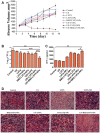Recent advances in PLGA micro/nanoparticle delivery systems as novel therapeutic approach for drug-resistant tuberculosis
- PMID: 35935487
- PMCID: PMC9355142
- DOI: 10.3389/fbioe.2022.941077
Recent advances in PLGA micro/nanoparticle delivery systems as novel therapeutic approach for drug-resistant tuberculosis
Abstract
Tuberculosis is a severe infectious disease caused by Mycobacterium tuberculosis and is a significant public health concern globally. The World Health Organization (WHO) recommends a combination regimen of several drugs, such as rifampicin (RIF), isoniazid (INH), pyrazinamide (PZA), and ethambutol (ETB), to treat tuberculosis. However, these drugs have low plasma concentrations after oral administration and require multiple high doses, which may lead to the occurrence and development of drug-resistant tuberculosis. Micro/Nanotechnology drug delivery systems have considerable potential in treating drug-resistant tuberculosis, allowing the sustained release of the drug and delivery of the drug to a specific target. These system properties could improve drug bioavailability, reduce the dose and frequency of administration, and solve the problem of non-adherence to the prescribed therapy. This study systematically reviewed the recent advances in PLGA micro/nanoparticle delivery systems as a novel therapeutic approach for drug-resistant tuberculosis.
Keywords: Mycobacterium tuberculosis; PLGA microparticles; PLGA nanoparticles; combination therapy; drug-resistant tuberculosis; inhalable therapy.
Copyright © 2022 Shao, Shen and Liu.
Conflict of interest statement
The authors declare that the research was conducted in the absence of any commercial or financial relationships that could be construed as a potential conflict of interest.
Figures












Similar articles
-
Nanotechnology-Based Drug Delivery Systems for Treatment of Tuberculosis--A Review.J Biomed Nanotechnol. 2016 Feb;12(2):241-60. doi: 10.1166/jbn.2016.2149. J Biomed Nanotechnol. 2016. PMID: 27305759 Review.
-
API TB Consensus Guidelines 2006: Management of pulmonary tuberculosis, extra-pulmonary tuberculosis and tuberculosis in special situations.J Assoc Physicians India. 2006 Mar;54:219-34. J Assoc Physicians India. 2006. PMID: 16800350
-
[Effectiveness and problems of PZA-containing 6-month regimen for the treatment of new pulmonary tuberculosis patients].Kekkaku. 2001 Jan;76(1):33-43. Kekkaku. 2001. PMID: 11211781 Review. Japanese.
-
[Prevalence and transmission of pyrazinamide-resistant Mycobacterium tuberculosis in Hunan Province,China].Zhonghua Jie He He Hu Xi Za Zhi. 2022 Jul 12;45(7):677-685. doi: 10.3760/cma.j.cn112147-20211219-00904. Zhonghua Jie He He Hu Xi Za Zhi. 2022. PMID: 35768376 Chinese.
-
[Development of antituberculous drugs: current status and future prospects].Kekkaku. 2006 Dec;81(12):753-74. Kekkaku. 2006. PMID: 17240921 Review. Japanese.
Cited by
-
Recent Advances in Nanotechnology-Based Strategies for Bone Tuberculosis Management.Pharmaceuticals (Basel). 2024 Jan 29;17(2):170. doi: 10.3390/ph17020170. Pharmaceuticals (Basel). 2024. PMID: 38399384 Free PMC article. Review.
-
Insights into Natural Products from Marine-Derived Fungi with Antimycobacterial Properties: Opportunities and Challenges.Mar Drugs. 2025 Jul 3;23(7):279. doi: 10.3390/md23070279. Mar Drugs. 2025. PMID: 40710504 Free PMC article. Review.
-
Development of High-Loading Trastuzumab PLGA Nanoparticles: A Powerful Tool Against HER2 Positive Breast Cancer Cells.Int J Nanomedicine. 2023 Nov 24;18:6999-7020. doi: 10.2147/IJN.S429898. eCollection 2023. Int J Nanomedicine. 2023. PMID: 38034948 Free PMC article.
-
Prophylactic and therapeutic potential of magnolol-loaded PLGA-PEG nanoparticles in a chronic murine model of allergic asthma.Front Bioeng Biotechnol. 2023 May 4;11:1182080. doi: 10.3389/fbioe.2023.1182080. eCollection 2023. Front Bioeng Biotechnol. 2023. PMID: 37214308 Free PMC article.
-
Inhibition of pulmonary artery smooth muscle cells via the delivery of curcuminoid WZ35 by Cu-based metal organic frameworks.IET Nanobiotechnol. 2023 Jul;17(5):420-424. doi: 10.1049/nbt2.12138. Epub 2023 May 16. IET Nanobiotechnol. 2023. PMID: 37194386 Free PMC article.
References
-
- Abdelghany S., Parumasivam T., Pang A., Roediger B., Tang P., Jahn K., et al. (2019). Alginate modified-PLGA nanoparticles entrapping amikacin and moxifloxacin as a novel host-directed therapy for multidrug-resistant tuberculosis. J. Drug Deliv. Sci. Technol. 52, 642–651. 10.1016/j.jddst.2019.05.025 - DOI
-
- Al-Qushawi A., Rassouli A., Atyabi F., Peighambari S. M., Esfandyari-Manesh M., Shams G. R., et al. (2016). Preparation and characterization of three tilmicosin-loaded lipid nanoparticles: Physicochemical properties and in-vitro antibacterial activities. Iran. J. Pharm. Res. 15 (4), 663–676. - PMC - PubMed
Publication types
LinkOut - more resources
Full Text Sources

